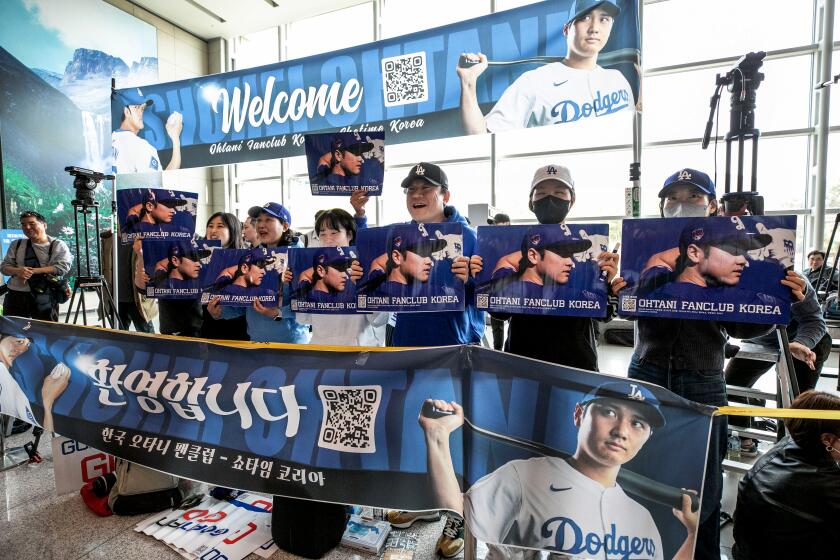The U.S. finally has a system to prevent deadly rail accidents. It took 50 years
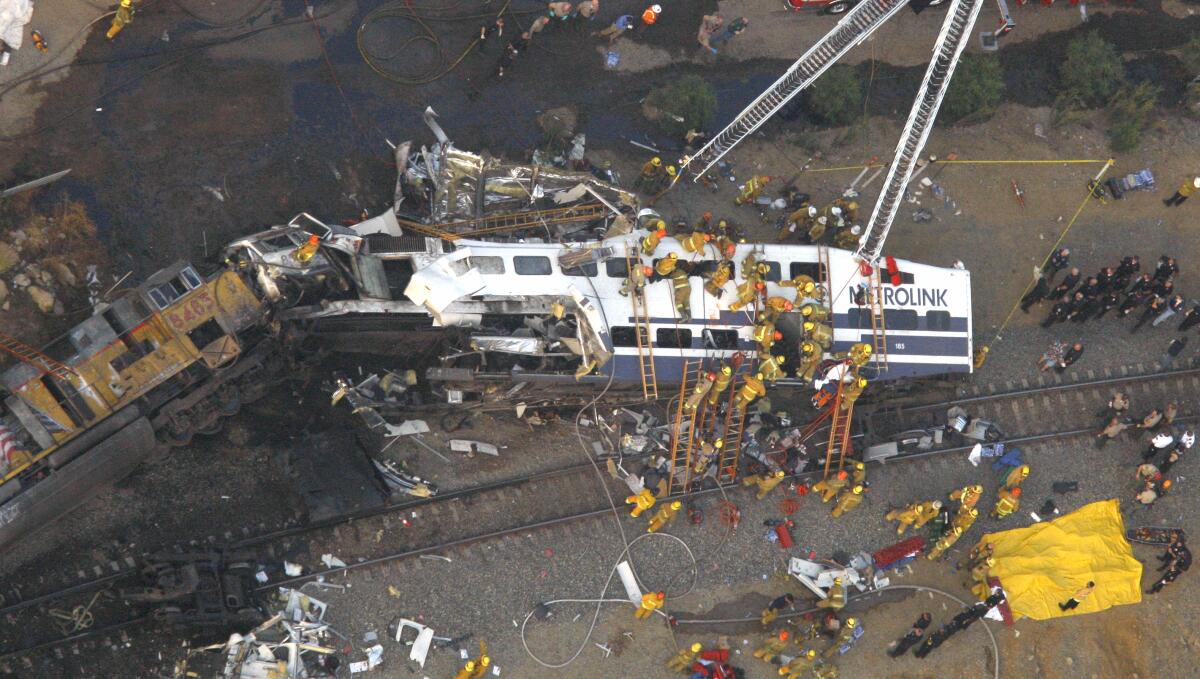
Hazy sunshine illuminated the suburban landscape as Eric Forbes settled into the seat of his Friday afternoon train.
It was Sept. 12, 2008, 4:22 p.m. Forbes, 56, an administrator at Cal State Northridge, was headed home to be there in time for his son’s first school dance. Relaxing, he watched out the window as the train rolled north from the Chatsworth station then banked to the left, heading for the narrow tunnel under the Santa Susana Pass. The curve allowed Forbes to see down the track. Motion caught his eye.
“I saw this train coming at us,” he recalls. A thought flashed through his mind: “There’s only one track there.”
“All I had time to do was grab the rail in front of me and brace.”
The next five seconds cost 25 lives. They would also break a long stalemate over rail safety. The result: A dozen years later — half a century after it was first proposed — one of the largest safety upgrades in railroad history took effect Friday.
Greg Tevis, who was sitting one car behind Forbes in his usual rear-facing seat, recalls those seconds through sounds.
It was like “a 155-millimeter artillery shell going off nearby hit me in both ears,” but “of a much deeper octave and much louder,” says Tevis, a former Marine, now 72 and retired.
“Everything inside the railcar except for the steel frames of the seats and me continued north westerly at 42 mph while the car, the frames and I were going in the other direction,” he wrote a few months after the accident. Passengers smashed into tables and walls. The fire extinguisher, kept in a small compartment on the wall, “emerged as a bullet.”
Next, a deathly silence. Then moaning. As Forbes and Tevis helped injured passengers, they could see a fire start where the locomotives had collided.

Investigators later determined that the engineer of the Metrolink train, texting on his phone, had run through a red signal. He was supposed to wait for the Union Pacific’s southbound Leesdale Local to divert onto a side track.
When Tim DePaepe, an investigator for the National Transportation Safety Board, arrived the next morning, police and firefighters were still recovering bodies from the mangled front car. The full investigation would take a year, but DePaepe immediately knew a key fact:
“It definitely was a preventable accident.”
Indeed, by then, the technology to avert it had been under discussion for 38 years.
The Chatsworth disaster brought that debate to an end. Within weeks, Congress passed legislation requiring a system known as “positive train control” nationwide.

Using GPS signals, wayside radio towers and onboard computers, positive train control can track every train in the U.S. moving across nearly 60,000 miles of track. It’s designed to automatically stop a train if an engineer runs a signal, or slow it down if it’s moving too fast.
The system cost some $14 billion, by industry estimates, and took nearly half a century.
How that happened provides a case study in the halting, sometimes confounding, course that safety regulation can take in the United States. It’s a winding path that typically takes place in federal agencies far from the center of political debate. Some officials have spent entire careers working on train-control issues.
The path is often blazed by avoidable deaths and “the tombstone mentality,” said Jennifer Homendy, an NTSB member, quoting her former boss, the late Democratic Rep. James Oberstar of Minnesota.
“We don’t do anything until people die, and it has to be a lot of people,” she said. It’s hard to explain to people, “especially if you’re talking to a family member” of someone who has died in an accident, “why it takes 50 years to implement a technology that saves lives.”
“It shouldn’t take that long.”
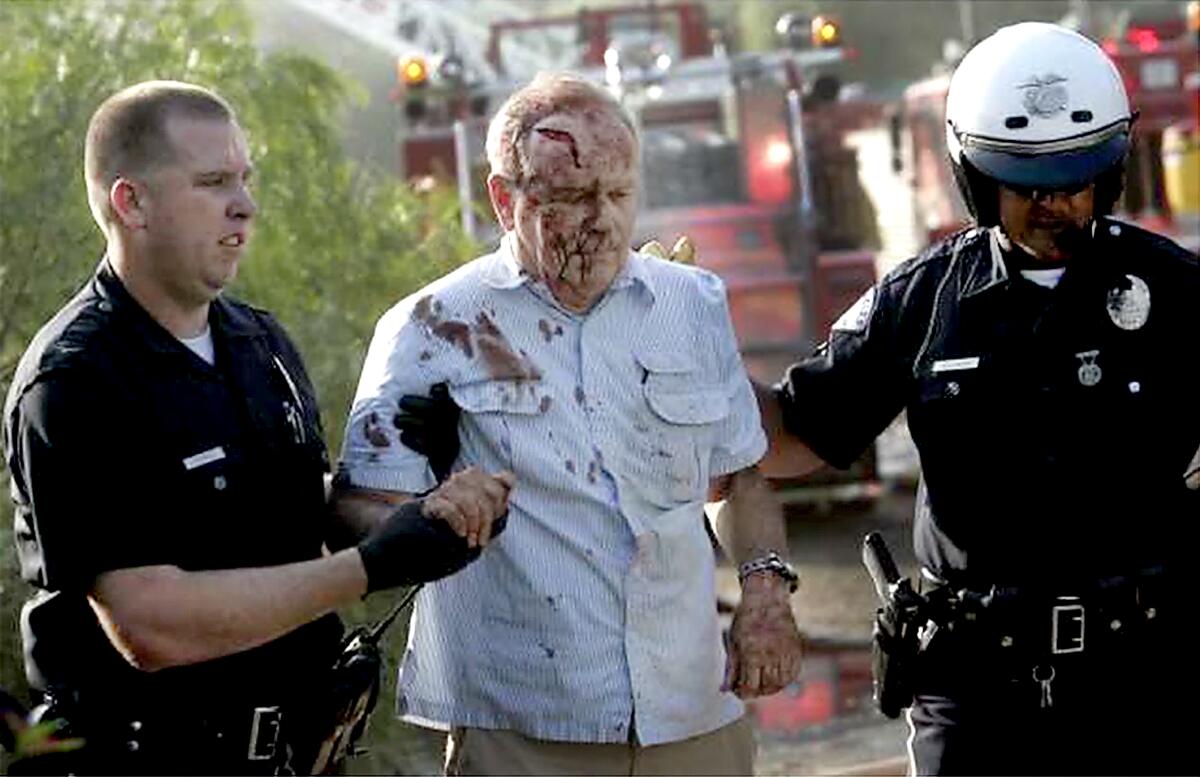
::
The debate began with a fatal accident.
On an August evening in 1969, two passenger trains hit head-on near Darien, Conn., some 40 miles northeast of New York City. Five people died. An engineer had ignored an instruction to yield, investigators found.
The NTSB has broad authority to examine accidents on the nation’s rails, airways, highways and waters, but no power to order new rules — a legal structure set up to keep investigations separate from the political trade-offs of regulation. In its report on the Darien collision, the board recommended that the Federal Railroad Administration consider “a form of automatic train control at points where passenger trains are required to meet other trains.”
That first glimmer of positive train control was singularly ill-timed: The U.S. rail industry, aging, poorly managed and encumbered by outmoded contracts and regulations, teetered on the edge of collapse. A new, multibillion-dollar project was a non-starter.
By the 1990s, however, as the industry began to stabilize, federal officials started to prod rail companies to look more seriously at the issue.
In 1991, the head of the Federal Railroad Administration convened a conference in Denver to discuss automated train controls. Even as they debated, officials received a reminder of the urgency, recalls Grady Cothen, then a senior safety officer at the agency.
“One of our guys came over to me and said, ‘There’s been an accident,’” Cothen said. A freight train had come in too fast to a small rail junction in Montana and slammed into a parked train. The freight’s conductor, seeing the collision about to take place, had leapt from the train to his death. His blood was still on the tie plates when Cothen and other officials arrived.
“When you go to an accident scene, you always remember it,” Cothen said.
In the mid-1990s, a study by the railroad administration found that roughly seven deaths a year could be prevented by automated controls. Cothen and others argued that automation would not only be safer but also would save the industry money. Rail executives believed that neither the lives saved nor the business benefits could justify the massive cost.

Several rail companies, led by Amtrak and BNSF, the country’s largest freight railroad, began pilot programs. But while major railroads were willing to experiment, “they didn’t have a commitment to implement,” Cothen said. And under federal rules that require the benefits of new regulations to outweigh the cost, the rail administration determined it could not order the railroads to act.
“We had felt that the systems would get implemented only when there was a very serious accident in a major metropolitan area,” Cothen said.
By the late 1990s, the NTSB had grown frustrated with the lack of action. The agency was refining a list of its “10 Most Wanted” safety improvements, and train control looked like it might not make the cut because prospects seemed so dim, recalled Robert Lauby, a safety board official at the time, who later became the head of rail safety for the railroad administration.
Lauby argued, successfully, for keeping train control on the list.
By then, the freight railroads, having consolidated and shed unprofitable lines, had regained financial stability and were about to enter what has become one of the most profitable periods in railroad history. The prospect for safety improvements began to brighten. In the early 2000s, Amtrak, as part of rebuilding the Northeast Corridor, began working on a train control system. Safety advocates began pushing Congress to require freight railroads to do likewise.
After Democrats regained a majority in 2006, the House passed a bill to mandate positive train control. Opposition from the industry kept the bill bottled up in the Senate.
The rail industry has long had a reputation as one of Washington’s most formidable lobbies. The other side is comparatively weak: Most Americans don’t ride trains. Rail safety lacks the immediate connection that can power campaigns for highway or airplane improvements.
On this issue, the freight railroads could count on support from commuter rail lines. A major new safety system could drive up passenger fares and potentially put some systems — already dependent on public subsidies — out of business, they argued.
Mike Rush, now senior vice president of the Assn. of American Railroads, the industry’s advocacy arm in Washington, insists the freight railroads did not oppose an automated safety system, but rail executives bridled at government mandating a multibillion-dollar expenditure.
“We would have preferred to develop PTC at our own pace,” he said. Eventually, that would have led to a nationwide system, he added, although it would certainly have taken longer.
For all those reasons, proposals for a law mandating train control “weren’t going anywhere” in 2008, he said.
“Chatsworth changed everything.”
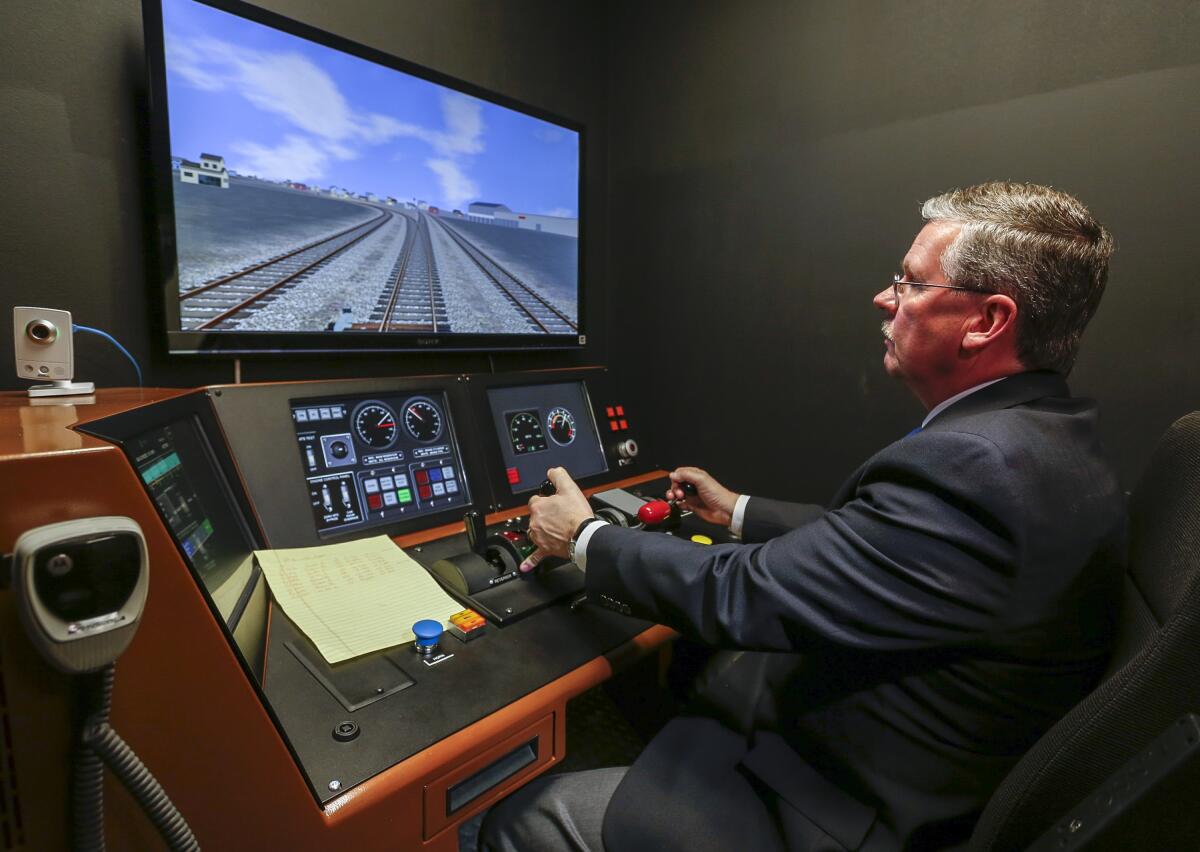
::
The quick passage of the rail safety law after the crash did not end the argument.
Congress had mandated a 2015 deadline, but the railroad administration still needed to write detailed regulations for what the system would look like and how much of the nation’s 140,000 miles of track would be covered. That process, including a trip through the courts, took four years.
In the meantime, some railroads, starting with Metrolink, dived in. In 2015, the Southern California commuter system became the first in the U.S. to fully install positive train control.
For most, however, creating the system would take much longer.
That was only in part because of resistance. Building a train control system was a “massive endeavor,” said Homendy, the NTSB member.
Americans have grown accustomed to GPS-based tracking that can pinpoint a car’s location. Automated train control, however, needs to not only locate a train but also stop it if necessary. That poses a more complex problem.
The system needs to know where on a map a track sits as well as “its topography, its switches,” Rush said. “Is it a train hauling coal or something lighter, like containers? Is the train going down a hill or up a hill when it needs to be braking? Is it going around a curve?”
At BNSF, Assistant Vice President Chris Matthews, who oversees the system, said the railroad had to build roughly 6,000 wayside towers to transmit signals along 11,500 miles of track and install onboard computers on 5,000 locomotives. Because engines from one railroad frequently travel over tracks owned by another, the systems used by each of the country’s seven major freight railroads and more than two dozen smaller freight and commuter lines needed to be fully interoperable.
“The scope has been immense,” Matthews said.
Not all railroads were enthusiastic. Some hunkered down and lobbied for delay. Those appeals drew sympathetic responses — and not only from the industry’s usual defenders in Congress.
President Obama’s regulatory chief, Cass Sunstein, criticized the 2008 law for mandating a system that could not pass a cost-benefit test. He backed pared-down rules.
The weighing of costs and benefits for new federal regulations, mandated by executive order since the Reagan administration, has long been debated. Supporters call it a crucial tool to ensure that government does not divert money and time to ideas that sound good but don’t improve public health or safety.
In the case of train control, government economists warned in the 1990s that higher costs for commuter railroads might lead so many riders to ditch the train and drive that highway fatalities would go up more than rail deaths would come down. Other studies showed that the lives saved — valued at just under $10 million per life, the current government standard — would not offset the cost.
Critics offer several counterarguments. Some denounce the idea of putting a price on human life. Others say the effort puts a false veneer of mathematical precision on an inherently subjective process. Still others note that costs and benefits never fall equally and say the supposedly objective weighing of the two almost always benefits the wealthy at the expense of the poor.
Opponents of positive train control argued that the money would be better spent on other safety improvements, like eliminating thousands of intersections where roads cross tracks — the most common cause of fatal rail accidents.
But to believe that the industry would have taken those billions and used them to make the rails safer ignores the real world, said Sarah Feinberg, who took over as head of the Federal Railroad Administration in January 2015, as the deadline for train control neared.
“This is not an industry that has bent over backwards to at every step ensure the safety of its workforce, the safety of the riding public, the general public,” said Feinberg, now president of the New York City Transit Authority. “This is an industry that was always pushing back.”
“It just isn’t an industry that can make that argument,” she said.
When Feinberg started her job at the railroad administration, Lauby, by then the agency’s safety chief, briefed her on the impending deadline: The message was that “no one’s going to make it. The railroads aren’t taking it seriously,” she recalled.
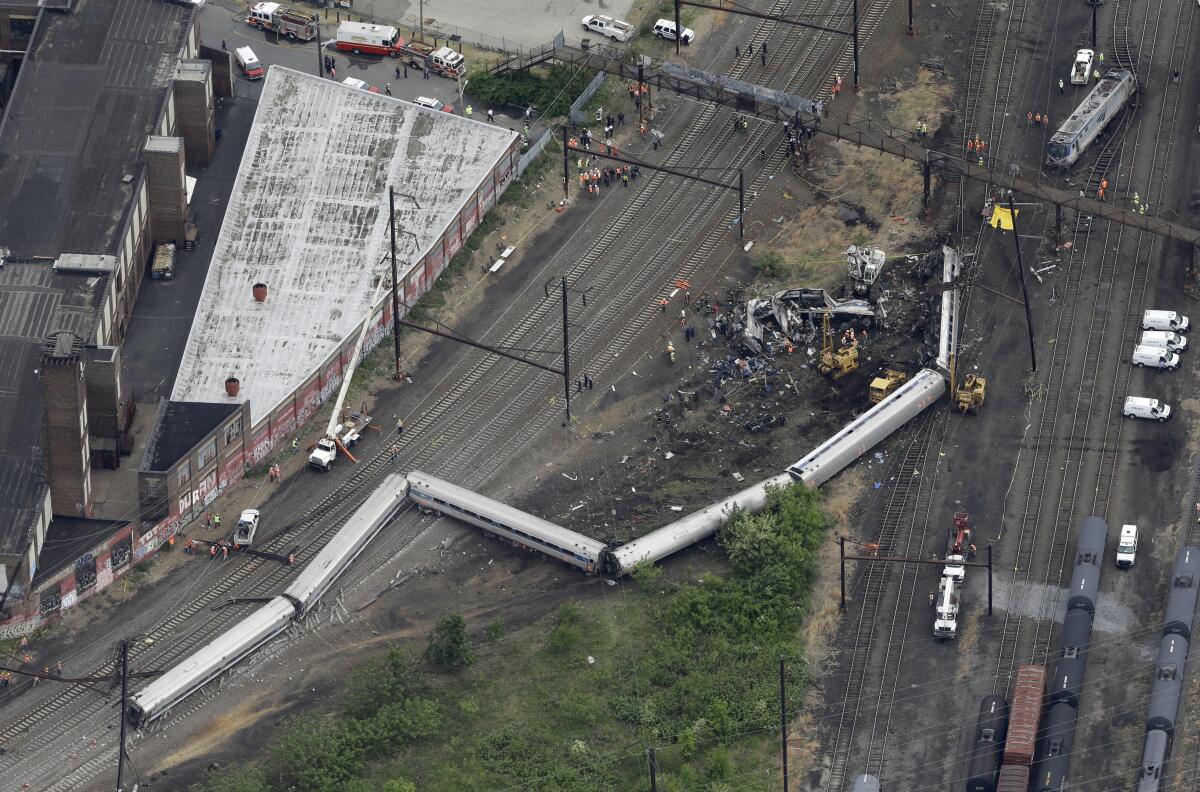
But as railroads lobbied to extend the deadline, an accident once again intervened.
This time, an Amtrak engineer, heading north out of Philadelphia, perhaps distracted by reports of rocks being thrown at another train, lost track of where he was and sped at 106 mph into a 50-mph curve. The train leaped off the track. Eight people died.
Amtrak had already installed train control equipment on its southbound tracks and was within weeks of installing it on the northbound side when the accident occurred in May 2015.
The Philadelphia crash bolstered Feinberg’s decision to take a hard line: If Congress, then under Republican control, was going to give the railroads more time, lawmakers would have to take responsibility for the decision themselves. The Obama administration would not provide them cover by asking for an extension on the railroads’ behalf.
The bruising congressional fight ended up yielding the railroads an additional five years but also made clear that Congress would not eliminate the requirement entirely.
Washington began supplying more money to commuter railroads to help pay the cost — a total of $3.4 billion by this year, according to the Transportation Department. And railroads increasingly began to accept the argument Cothen had made three decades ago — that automation could not only bolster safety but also significantly improve efficiency and fuel economy.
“We put it in as a safety system,” said Matthews, the BNSF official. “But what it’s given us is some fundamental building blocks that we can use going forward” to automate operations.
In the future, “computers will drive the train,” said Rush, much as autopilots now largely fly commercial jets.
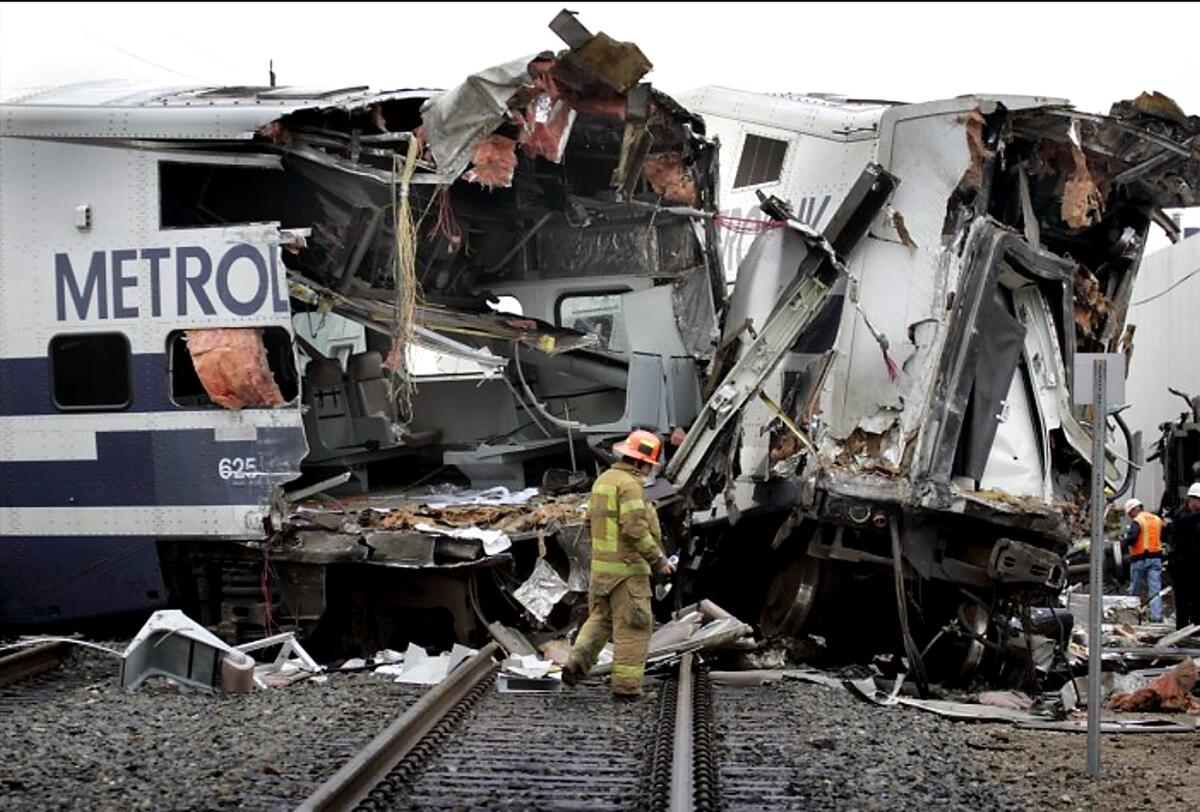
::
DePaepe, the NTSB investigator, was attending a college volleyball game in Kenosha, Wis., when he was alerted to the Chatsworth accident. He caught a 6 a.m. flight out of Chicago.
Typically, when investigators arrive at an accident, “things will be relatively cleaned up,” he said. In Chatsworth, the scene when he arrived remained “horrific.”
Three refrigerated morgue trucks stood nearby to receive the bodies. The body of the Metrolink engineer lay under a tarp.
“When you see things of that magnitude, it’s difficult to process,” DePaepe said. The only thing to do is to focus on the task and hope that “what comes out of my report can prevent it from happening again.”
Though the arrival of train control this year won’t eliminate every accident, it will prevent “the largest and most horrific” ones, he said. At the safety board, which advocated the system for decades, there’s a feeling of accomplishment, tinged by regret that it took so long.
As an official of the Brotherhood of Railroad Signalmen, DePaepe began work on train control issues as part of a committee of government, labor and industry experts. That was in 1994.
He recalled that his father, Hank, also a signalman, predicted when he started that “you’ll be retired before that regulation is in force.”
DePaepe was 37 at the time.
“I laughed,” he said. “Well, I’m retiring next year. My dad was off by a year.”
Times staff writer Maloy Moore in Los Angeles contributed to this report.
More to Read
Start your day right
Sign up for Essential California for news, features and recommendations from the L.A. Times and beyond in your inbox six days a week.
You may occasionally receive promotional content from the Los Angeles Times.







